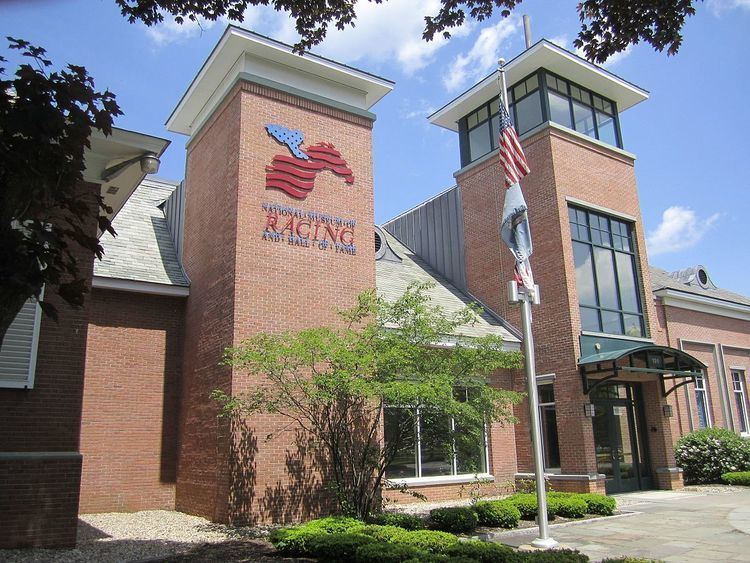Established 1950 Curator Victoria Tokarowski Phone +1 518-584-0400 | Director Christopher Dragone Website racingmuseum.org Date founded 1950 | |
 | ||
Hours Closed today TuesdayClosedWednesday10AM–4PMThursday10AM–4PMFriday10AM–4PMSaturday10AM–4PMSunday10AM–4PMMondayClosedSuggest an edit Similar Saratoga Race Course, Belmont Park, Saratoga Automobile Museum, Canfield Casino and Congress, National Museum of Dance an Profiles | ||
Race replay 2016 national museum of racing and hall of fame stakes
The National Museum of Racing and Hall of Fame was founded in 1950 in Saratoga Springs, New York, to honor the achievements of American Thoroughbred race horses, jockeys, and trainers. In 1955, the museum moved to its current location on Union Avenue near Saratoga race course, at which time inductions into the hall of fame began. Each spring, following the tabulation of the final votes, the announcement of new inductees is made, usually during Kentucky Derby Week in early May. The actual inductions are held in mid-August during the Saratoga race meeting.
Contents
- Race replay 2016 national museum of racing and hall of fame stakes
- Wallyanna 2014 national museum of racing and hall of fame
- Horses in the Hall of Fame
- Jockeys in the Hall of fame
- Trainers in the Hall of Fame
- Exemplars of Racing
- Pillars of the Turf
- Museum Exhibits
- United States Thoroughbred Racing Hall of Fame
- References
The Hall of Fame's nominating committee selects eight to ten candidates from among the four Contemporary categories (male horse, female horse, jockey and trainer) to be presented to the voters. Changes in voting procedures that commenced with the 2010 candidates allow the voters to choose multiple candidates from a single Contemporary category, instead of a single candidate from each of the four Contemporary categories. For example, in 2016, two female horses (Rachel Alexandra and Zenyatta) were inducted at the same time.
The museum also houses a large collection of art, artifacts, and memorabilia that document the history of horse racing from the eighteenth century to the present.
Wallyanna 2014 national museum of racing and hall of fame
Horses in the Hall of Fame
Under current rules, a horse must have been retired for a minimum of five full calendar years to be eligible for the hall of fame. Thoroughbreds remain eligible between five and 25 calendar years following their final racing year. Thoroughbreds retired for more than 25 calendar years become eligible through the Historic Review Committee. In the early years, inductions were made exclusively through historical review. In 1955, a group of 9 horses from the earliest years of the American turf were inducted. The 1956 class included 11 horses that raced around the turn of the century, while the 1957 class included 10 horses that raced up to the mid-thirties. Since then, the classes have been significantly smaller as the inductions shifted to more contemporary horses.
Jockeys in the Hall of fame
To be eligible for the Hall of Fame, a jockey must be licensed for 20 years or have been retired for at least five years.
Trainers in the Hall of Fame
To be eligible for the Hall of Fame, a trainer must be licensed and actively involved with Thoroughbreds for at least 25 years or have been retired for a minimum of five years.
Exemplars of Racing
The National Museum of Racing and Hall of Fame has named only five people in the history of American Thoroughbred horse racing as "Exemplars of Racing."
Pillars of the Turf
Established in 2013, the Hall of Fame states that the Pillars of the Turf category honors those "who have made extraordinary contributions to Thoroughbred racing in a leadership or pioneering capacity at the highest national level."
Museum Exhibits
In addition to the Hall of Fame, the museum houses numerous exhibits. These include:
The Museum Collection includes just over 300 paintings. These range from paintings of the early days of racing in England by John E. Ferneley, Sr. to more contemporary champions by Richard Stone Reeves. Featured artists include: William Smithson Broadhead, Vaughn Flannery, Sir Alfred J. Munnings, Frederic Remington, Martin Stainforth, George Stubbs, Henry Stull, Edward Troye and Franklin Brooke Voss. Also on display are Kelso's five Jockey Club Gold Cup trophies and the Triple Crown trophies of Count Fleet.
